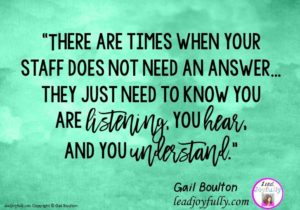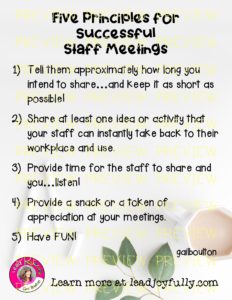Do you look forward to staff meetings? Most people would answer that question with a resounding, NO!
Thirty-minute meetings turn into 90-minute meetings while you’re wondering if you’ll have time to run your errands that day. Too much talk on the part of the leader or too much talk from that staff member that dominates the conversation. No practical applications to the real-world workplace…and for Pete’s sake where is the snack food?!?
I’m not going to tell you that every one of my staff meetings or grade level meetings with teachers were thrilling to attend; however, there were a lot more meaningful conversations and a lot more laughter when I followed these five general principles:

1) Tell them approximately how long you intend to share…and keep it as short as possible!
For example, I started most grade-level meetings telling them, “I’ve got about 10-15 minutes of information and I will be showing you _____, then you are free to go.” That meeting might be 40 minutes (they knew this beforehand) and that I would be available during the remaining time. They had that time to share their concerns or ask questions.
Remember, not all information you deem necessary to share needs to be conveyed in a staff meeting. If you’ve stated it in an electronic correspondence of some type, there is no need to repeat it! Hold them accountable for reading the necessary information you share. Mark those accountability emails as “priority” (or earmark in some way) to communicate clearly what they are accountable for reading. And don’t overuse.
I remember at the beginning-of-the-school-year attending a Central Office meeting that lasted all day. Every department head was given time to share what they intended principals to remind their staff of. I had at least 10 pages of notes! It overwhelmed me, so I knew it would overwhelm the staff. Isn’t that a beginning of the year complaint from staff members anyway? They get overwhelmed…which equates to stress. They just want to be in their classrooms. Try to keep your information short…and sweet. 🙂
2) Share at least one idea or activity that your staff can instantly take back to their workplace and use.
As leaders, you model for your staff on a daily basis. When meeting with staff, modeling something practical that they can immediately utilize is important. It’s professional development time in a bottle. Quick training sessions that can pack a punch! For schools, it’s everything from classroom management, working with parents, writing, math, science, reading, etc.! Pick activities that are important to the needs of your campus or workplace.

At one staff meeting, I put one round colored sticker on the back of the staff’s hand as they signed in. To start the activity, they find the two other colors (people) and make a group of three. Tell them they are going to tell a story. To make them feel comfortable, I probably would insert that it didn’t need to be perfect, it wasn’t going to be shared with the entire room, and then give them a time limit, etc. Just remember to keep it simple. I also told them they had to be able to remember their part after they spoke it. It had to be short enough to remember. HA! The pink was the beginning, orange the middle, and green was the ending. After the first storytelling, they switched and formed a totally new group of three. This time they were to re-tell their story parts in order. Lots of laughter after that one. Then summarize. I told them they could use that activity with their students for writing ideas then expounded and gave them more ideas. If you have time, have them add to the ideas. The activity was short and sweet…and practical!
You also don’t have to lead the activity each time. Perhaps you’ve seen something in the classroom that you think others would benefit from. Ask that staff member to do a short teaching!

3) Provide time for the staff to share and you…listen!
Remember the 10 pages of notes from a Central Office meeting? I streamlined and organized the information I received in a succinct way and handed the notes to my campus at a staff meeting. I voiced the important points and told them they were accountable to read through the rest of the information before ______ and gave them a date. They were then free to leave if they wanted to. If you allow them time to share and/or ask questions, the detail-oriented staff members will be sticking around to ask about those notes. A perfect time to put them at ease. Your global (not worried about the details) people will not have to sit there in agony!
A good leader is one who knows how to listen. I had to practice this one. My mind has a tendency to start problem-solving answers. There are times when your staff does not need an answer…they just need to know you are listening, you hear, and you understand. Give your staff time to share.
4) Provide a snack or a token of appreciation at your meetings.
I recently read The 5 Languages of Appreciation in the Workplace: Empowering Organizations by Encouraging People by Gary Chapman and Paul White. The authors’ state:
“…according to research conducted by the US Department of Labor, 64 percent of Americans who leave their jobs say they do so because they don’t feel appreciated. This is true of employees across the board, from CEOs to housekeeping staff. Something within the human psyche cries out for appreciation. When that need is unmet, then job satisfaction will be diminished.”
I don’t believe you have to go overboard with providing snacks or tokens of appreciation to your staff; however, I do believe it speaks to many of your staff’s primary appreciation language.
5) Have FUN!
You know I can’t leave out the fun factor! I really enjoyed holding grade-level meetings. Each grade level had its own personality. It was a time I could differentiate between each group and also a time I could get to know them better.
I don’t remember exactly how it got started, but my 2nd-grade team meeting always started with a fashion tip. Seriously, I am the least likely person to give fashion tips even though my motto is, “Simple but Elegant”. I relied on my daughter to tell me the latest trends and the internet search engine for the rest. It was fun…and funny!

I was fortunate to have a large office where I met with my grade-level teams. The couches in this picture were about 30 years old. No joke! They came from my house when we bought new and were moved from classroom to classroom and eventually my office. They were so comfy (aka old) that if you sat down, you sunk! When I told the staff they could leave after I finished sharing or they could stay and talk, I rarely had anyone leave. Perhaps they felt swallowed up by the couch??
Hopefully, they were comfortable about hanging out in a staff meeting!
[Grab your free copy of the 5 principles by clicking the picture.]
Lead joyfully,
Gail Boulton






Leave a Reply